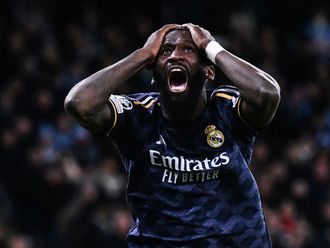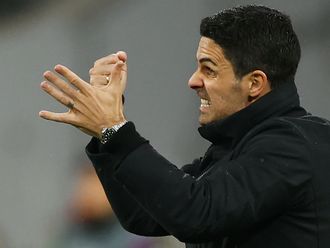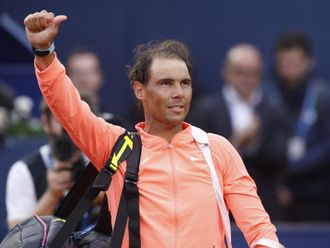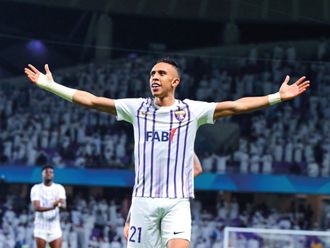
With just 64 days until the 2014 Fifa World Cup kicks off in the spiritual home of football, there are still issues Brazil is striving to rectify before the world’s spotlight is in full glare on Sao Paulo.
The country is wheeling out its legends to remind the world that it is football that should be in focus — and not the glitches in the run-up to the event it has invested £6.6 billion (Dh40.4 billion)
in developing.
Two-time Ballon d’Or winner and Real Madrid legend Ronaldo said in his column in The Guardian last month: “With the World Cup and the 2016 Olympics
taking place here, we will prove to the world not just how much we love sport — but also how strong we are economically.” Not for the first time in his life, Ronaldo hits the sweet spot. The world is certainly eager to see the real Brazil in all its young demo-
cratic exuberance.
Fifa President Sepp Blatter perfectly expressed the concerns of football fans across the world in a video posted on Fifa.com to mark the 100-days-to-go point, by saying: “One hundred days; it’s a long way to go, and it’s a short way to go if there are
still problems.”
State of the stadia
Ultimately, and sadly, much of the pre-tournament hype is focusing on the readiness of Brazil’s stadia, upon which its success, which always needs to be quanitifiable today, will hinge. At the time of writing, three of the 12 stadia remain unfinished:
Cuiaba, Sao Paulo and Curtiba.
The 12 venues spread across Brazil’s vast 8.5-million-square-kilometre landscape range from the stunning 73,000-plus capacity Maracana in Rio de Janeiro to the troubled 48,000-seater Estadio Beira-Rio in Porto Alegre.
But beneath the glistening veneer of artist’s impressions, fatalities are mounting up.
The devastating crane collapse at the Sao Paulo Arena Corinthians stadium that killed two workers at the end of 2013 has raised concerns that the rush to get the iconic stadium completed in time is putting the workforce at risk.
However, a spokesperson for Andres Sanchez, former Corinthians Chairman and site construction supervisor at the Itaquerao stadium, told AFP, “The site will be delivered on April 15 with only a few issues to finish off thereafter.
“What Fifa has asked for will be finished,” the spokesperson added, without specifying what these remaining issues are. The venue is scheduled to host the opening game of the tournament between Brazil and Croatia on June 12. Other reports say that the Sao Paulo stadium will not be ready until May.
Solar cup
There is some good news for Brazil and the watching world regarding its stadia though; seven of 12 stadiums will use solar arrays to generate on-site power , making this World Cup one of the most sustainable to date.
The Estadio Nacional, in capital city Brasilia, is one of the first-ever Leadership in Energy and Electronic Design (Leed) Platinum stadiums in the world. The Maracana stadium in Rio has also been retrofitted with 1,500 solar rooftop panels, and has applied for Leed status.
The Estadio Mineirao, in Belo Horizonte, stands out as perhaps the best example. Completed well within Fifa’s original December 31 deadline, a $16.1-million (Dh 59.1 million) investment has seen an impressive
solar-panelled roof laid over the stadium’s exterior.
Carnival culture
Nothing compares to the vibrant Brazilian attitude towards football, which finds an apt counterpart in the annual carnival. The colour and enthusiasm the 200-million-strong populace infuses the beautiful game with a je ne se quoi other countries
can only dream of. A party atmosphere will engulf stadia and city streets on game days, infecting match-goers and television audiences with an inimitable Latin American spirit — it’s sure to be ‘Brazilliant’.
Airport delays
While the World Cup is on, Brazil will reportedly attract 600,000 international football fans: you can imagine the snaking immigration lines already.
A fourth terminal at Sao Paulo’s airport is expected to open this month. A second terminal at Manaus is unfinished, and there are worries that the 45-minute queues seen during run-of-the-mill weekdays are only likely to increase in size and intensity by the time Brazil 2014 rolls around if terminal two is not completed.
The team
One thing is always guaranteed in football: Brazil will have the most exciting young talent in the world. As hosts of this year’s tournament, 2014 will be no exception. Most teams would feel the pressure of a nation’s expectation with Brazil’s unrivalled history of international footballing achievements. But the exuberance of youth takes such demands in its stride. Neymar, Oscar, Willian and the ominously named Hulk are the shining stars in a typically free-flowing outfit.
Jairzinho, one of Brazil’s heroes from their iconic 1970 side, told AFP: “I can only say today there is a lack of stars in Brazilian football. In 1970, we had practically 11 stars out there on the field.”
Though Neymar’s glitzy skills displayed for club side FC Barcelona may be a sufficient rebuttal of Jairzinho’s comments in themselves, the final word will rest with the players that don the famous yellow jersey.
Speaking exclusively to Gulf News last month, three-time World Cup-winning demigod Pelé, said: “Neymar is my favourite [player] at the moment.”
Surely that’s the best riposte to his former teammate Jairzinho’s concerns?










